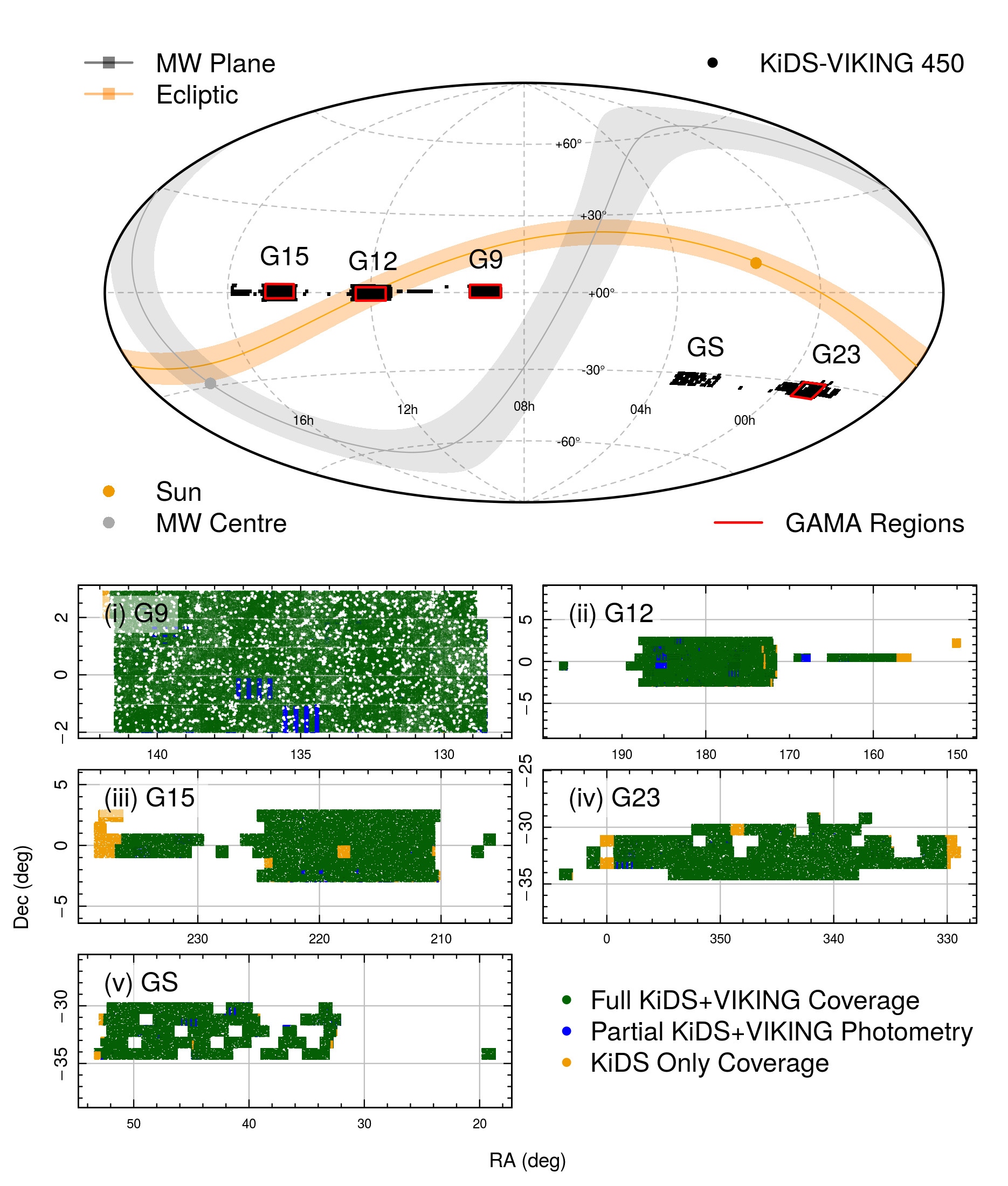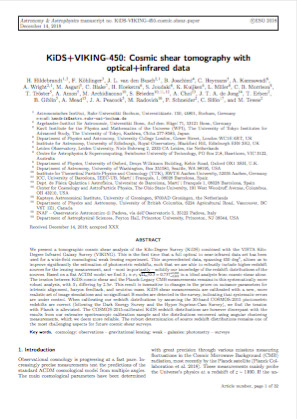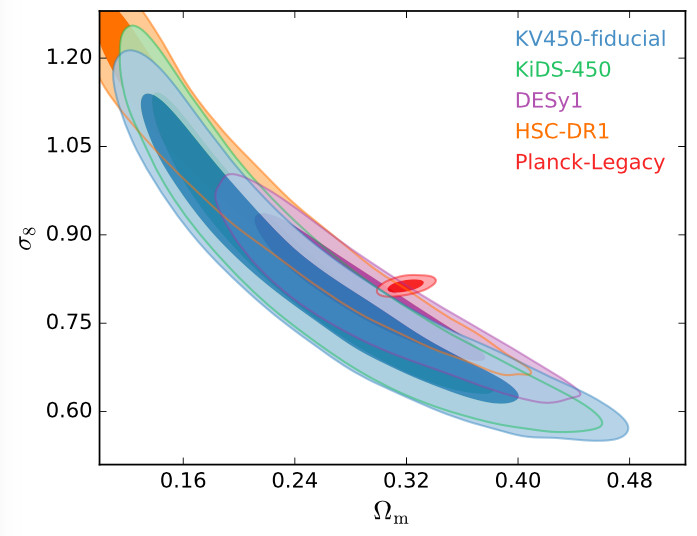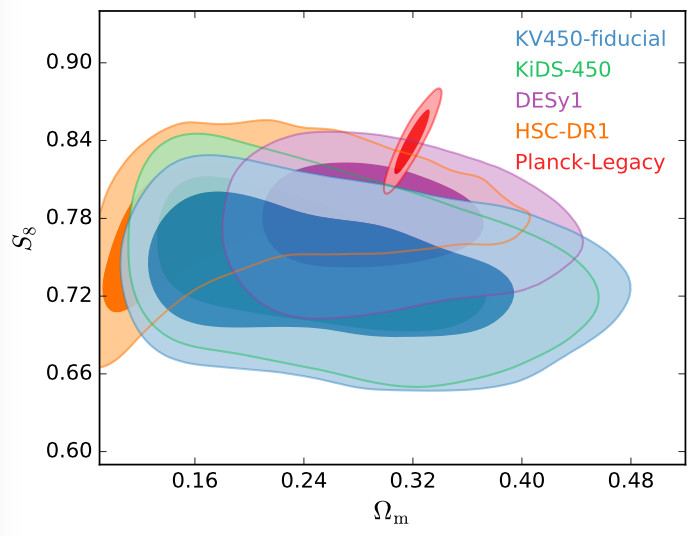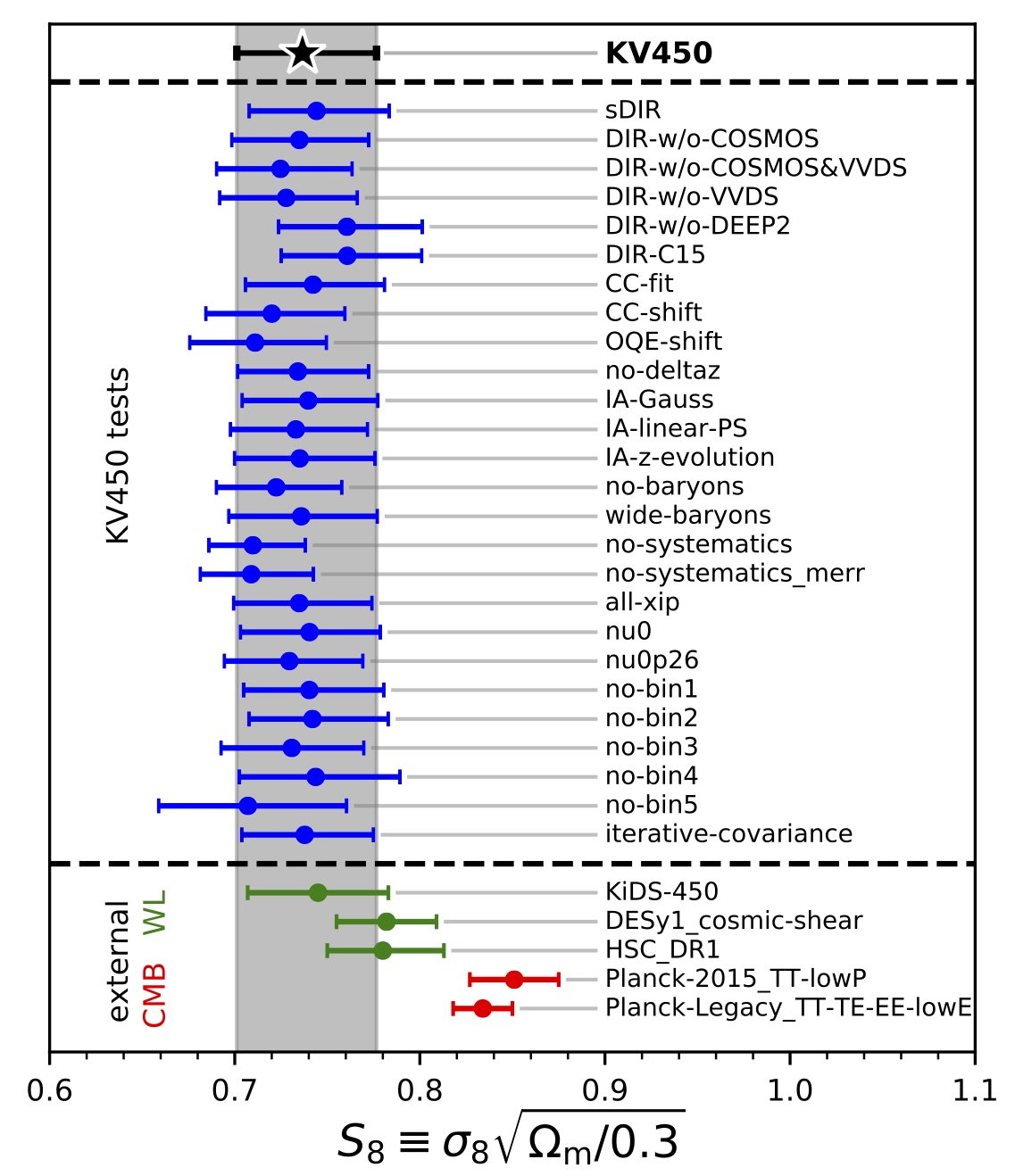KiDS+VIKING-450: Cosmic shear tomography with optical+infrared data
Welcome to the webpage dedicated to the release of data products that were used in the KiDS+VIKING-450 cosmic shear analysis published in Hildebrandt et al. (2018). This analysis is based on 450 sq. deg. of 9-band (ugriZYJHKs) KiDS+VIKING data described in Wright et al. (2018). The footprint of the survey is shown in Fig.1.
Fig. 1: Combined KiDS+VIKING-450 data set.
Paper
KiDS+VIKING-450: Cosmic shear tomography with optical+infrared data
H. Hildebrandt, F. Köhlinger, J. L. van den Busch, B. Joachimi, C. Heymans, A. Kannawadi, A. Wright, M. Asgari, C. Blake, H. Hoekstra, S. Joudaki, K. Kuijken, L. Miller, C. B. Morrison, T. Tröster, A. Amon, M. Archidiacono, S. Brieden, A. Choi, J. T. A. de Jong, T. Erben, B. Giblin, A. Mead, J. A. Peacock, M. Radovich, P. Schneider, C. Sifón, and M. Tewes
We present a tomographic cosmic shear analysis of the Kilo-Degree Survey (KiDS) combined with the VISTA Kilo- Degree Infrared Galaxy Survey (VIKING). This is the first time that a full optical to near-infrared data set has been used for a wide-field cosmological weak lensing experiment. This unprecedented data, spanning 450 deg2, allows us to improve significantly the estimation of photometric redshifts, such that we are able to robustly include higher-redshift sources for the lensing measurement, and - most importantly - solidify our knowledge of the redshift distributions of the sources. Based on a flat ΛCDM model we find S8 ≡ σ8 √(Ωm/0.3) = 0.737+0.040-0.036 in a blind analysis from cosmic shear alone. The tension between KiDS cosmic shear and the Planck-Legacy CMB measurements remains in this systematically more robust analysis, with S8 differing by 2.3σ. This result is insensitive to changes in the priors on nuisance parameters for intrinsic alignment, baryon feedback, and neutrino mass. KiDS shear measurements are calibrated with a new, more realistic set of image simulations and no significant B-modes are detected in the survey, indicating that systematic errors are under control. When calibrating our redshift distributions by assuming the 30-band COSMOS-2015 photometric redshifts are correct (following the Dark Energy Survey and the Hyper Suprime-Cam Survey), we find the tension with Planck is alleviated. The COSMOS-2015-calibrated KiDS redshift distributions are however discrepant with the results from our extensive spectroscopic calibration sample and the distributions recovered using angular clustering measurements, which we deem more reliable. The robust determination of source redshift distributions remains one of the most challenging aspects for future cosmic shear surveys.
Full paper: Hildebrandt et al. 2018, A&A, 633, A69, arXiv:1812.06076 (PDF) (arXiv)
Main result
Figure 2 shows the constraints in the Omegam vs. σ8 plane from KV450 cosmic shear tomography (blue), the KiDS-450 optical-only cosmic shear measurement from Hildebrandt et al. (2017, green), two other optical-only cosmic shear experiments, DESy1 in purple (Troxel et al. 2018) and HSC-DR1 in orange (Hikage et al. 2018), as well as the Planck-Legacy CMB results (Planck Collaboration 2018).
Fig. 2
The parameter that is best constrained by cosmic shear is a combination of Ωm and σ8 called S8=σ8√(Ωm/0.3). The KV450 constraints for different setups and external constraints are shown in Fig.3
Fig. 3
Data products
Primary Monte Carlo Markov Chain
The primary analysis (corresponding to the blue contours in Fig.2 and the black star in Fig.3) uses the most sophisticated treatment of systematic errors and the best redshift distributions and is available here together with a README file describing its creation and further use:
- Monte Carlo Markov Chain: tar.gz (1.7 MB) or FITS (1.8 MB)
- kv450_mcmc_README.txt
KV450 Shear catalogues
The KiDS+VIKING-450 shear catalogues are publicly available. Please visit the following webpage for further details.
KV450 Shear data products
The following data products are also made publicly available here:
- The Data Vector (tomographic two-point correlation function)
- The Covariance Matrix
- Different versions of the KV450 redshift distribution
- Shear data: KV450_COSMIC_SHEAR_DATA_RELEASE.tar.gz (1.1 MB)
- kv450_sheardata_README.txt
Contacts
For questions please contact Hendrik Hildebrandt (hendrik@astro.ruhr-uni-bochum.de).
Acknowledgements
Users of these data should include the following acknowledgment to the source of the data:
Based on data products from observations made with ESO Telescopes at the La Silla Paranal Observatory under programme IDs 177.A-3016, 177.A-3017, 177.A-3018, 179.A-2004, and 298.A-5015.
and should cite Hildebrand et al. (2018), Kannawadi et al. (2018), Wright et al. (2018), and accompanying papers as follows:
We use cosmic shear measurements from the Kilo-Degree Survey and the VISTA Kilo-Degree Infrared Galaxy Survey (Kuijken et al. 2015, Wright et al. 2018, Hildebrandt et al. 2018, Kannawadi et al. 2018), hereafter referred to as KiDS+VIKING. The KiDS data are processed by THELI (Erben et al. 2013) and Astro-WISE (Begeman et al. 2013, de Jong et al 2017), and the VIKING data are processed by CASU (Gonzalez-Fernandez et al. 2018). Shears are measured using lensfit (Miller et al. 2013, Kannawadi et al. 2018), and photometric redshifts are obtained from PSF-matched photometry (Wright et al. 2018) and calibrated using external overlapping spectroscopic surveys (Hildebrandt et al. 2018).

